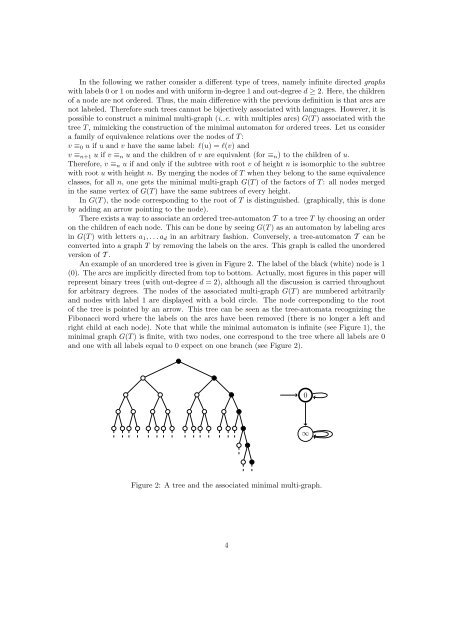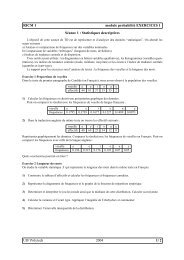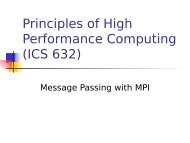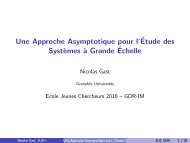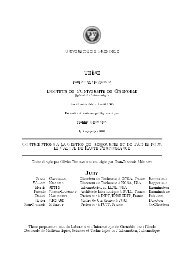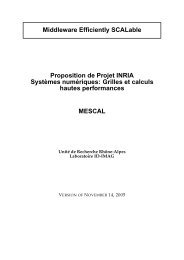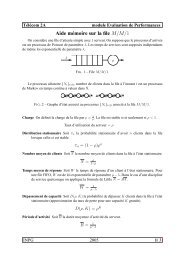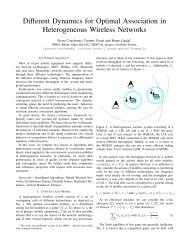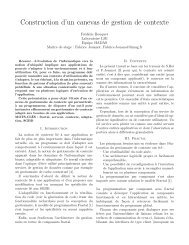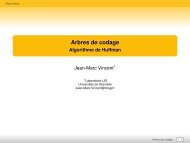Distributing labels on infinite trees
Distributing labels on infinite trees
Distributing labels on infinite trees
You also want an ePaper? Increase the reach of your titles
YUMPU automatically turns print PDFs into web optimized ePapers that Google loves.
In the following we rather c<strong>on</strong>sider a different type of <strong>trees</strong>, namely <strong>infinite</strong> directed graphswith <str<strong>on</strong>g>labels</str<strong>on</strong>g> 0 or 1 <strong>on</strong> nodes and with uniform in-degree 1 and out-degree d ≥ 2. Here, the childrenof a node are not ordered. Thus, the main difference with the previous definiti<strong>on</strong> is that arcs arenot labeled. Therefore such <strong>trees</strong> cannot be bijectively associated with languages. However, it ispossible to c<strong>on</strong>struct a minimal multi-graph (i..e. with multiples arcs) G(T ) associated with thetree T , mimicking the c<strong>on</strong>structi<strong>on</strong> of the minimal automat<strong>on</strong> for ordered <strong>trees</strong>. Let us c<strong>on</strong>sidera family of equivalence relati<strong>on</strong>s over the nodes of T :v ≡ 0 u if u and v have the same label: l(u) = l(v) andv ≡ n+1 u if v ≡ n u and the children of v are equivalent (for ≡ n ) to the children of u.Therefore, v ≡ n u if and <strong>on</strong>ly if the subtree with root v of height n is isomorphic to the subtreewith root u with height n. By merging the nodes of T when they bel<strong>on</strong>g to the same equivalenceclasses, for all n, <strong>on</strong>e gets the minimal multi-graph G(T ) of the factors of T : all nodes mergedin the same vertex of G(T ) have the same sub<strong>trees</strong> of every height.In G(T ), the node corresp<strong>on</strong>ding to the root of T is distinguished. (graphically, this is d<strong>on</strong>eby adding an arrow pointing to the node).There exists a way to associate an ordered tree-automat<strong>on</strong> T to a tree T by choosing an order<strong>on</strong> the children of each node. This can be d<strong>on</strong>e by seeing G(T ) as an automat<strong>on</strong> by labeling arcsin G(T ) with letters a 1 , . . . a d in an arbitrary fashi<strong>on</strong>. C<strong>on</strong>versely, a tree-automat<strong>on</strong> T can bec<strong>on</strong>verted into a graph T by removing the <str<strong>on</strong>g>labels</str<strong>on</strong>g> <strong>on</strong> the arcs. This graph is called the unorderedversi<strong>on</strong> of T .An example of an unordered tree is given in Figure 2. The label of the black (white) node is 1(0). The arcs are implicitly directed from top to bottom. Actually, most figures in this paper willrepresent binary <strong>trees</strong> (with out-degree d = 2), although all the discussi<strong>on</strong> is carried throughoutfor arbitrary degrees. The nodes of the associated multi-graph G(T ) are numbered arbitrarilyand nodes with label 1 are displayed with a bold circle. The node corresp<strong>on</strong>ding to the rootof the tree is pointed by an arrow. This tree can be seen as the tree-automata recognizing theFib<strong>on</strong>acci word where the <str<strong>on</strong>g>labels</str<strong>on</strong>g> <strong>on</strong> the arcs have been removed (there is no l<strong>on</strong>ger a left andright child at each node). Note that while the minimal automat<strong>on</strong> is <strong>infinite</strong> (see Figure 1), theminimal graph G(T ) is finite, with two nodes, <strong>on</strong>e corresp<strong>on</strong>d to the tree where all <str<strong>on</strong>g>labels</str<strong>on</strong>g> are 0and <strong>on</strong>e with all <str<strong>on</strong>g>labels</str<strong>on</strong>g> equal to 0 expect <strong>on</strong> <strong>on</strong>e branch (see Figure 2).0∞Figure 2: A tree and the associated minimal multi-graph.4


